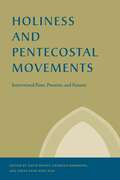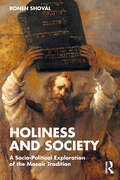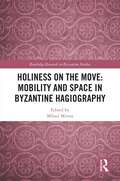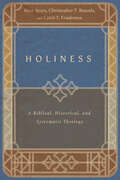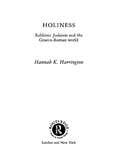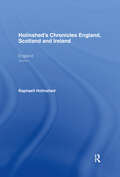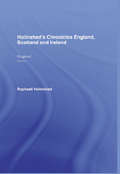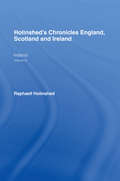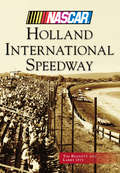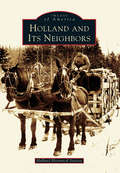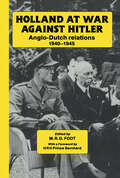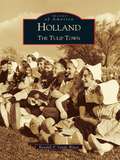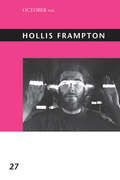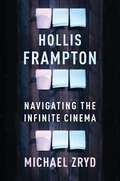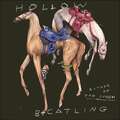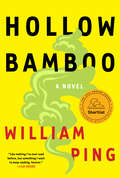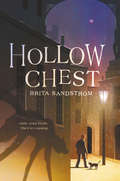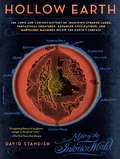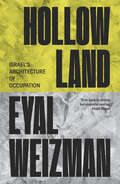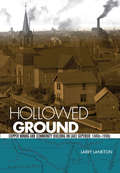- Table View
- List View
Holiness and Pentecostal Movements: Intertwined Pasts, Presents, and Futures (Studies in the Holiness and Pentecostal Movements)
by David Bundy, Geordan Hammond, and David Sang-Ehil HanSince the 1830s, Holiness and Pentecostal movements have had a significant influence on many Christian churches, and they have been a central force in producing what is known today as World Christianity. This book demonstrates the advantages of analyzing them in relation to one another.The Salvation Army, the Church of the Nazarene, the Wesleyan Church, and the Free Methodist Church identify strongly with the Holiness Movement. The Assemblies of God and the Pentecostal Assemblies of the World identify just as strongly with the Pentecostal Movement. Complicating matters, denominations such as the Church of God (Cleveland), the International Holiness Pentecostal Church, and the Church of God in Christ have harmonized Holiness and Pentecostalism. This book, the first in the new series Studies in the Holiness and Pentecostal Movements, examines these complex relationships in a multidisciplinary fashion. Building on previous scholarship, the contributors provide new ways of understanding the relationships, influences, and circulation of ideas among these movements in the United States, the United Kingdom, India, and Southeast and East Asia.In addition to the editors, the contributors are Kimberly Ervin Alexander, Insik Choi, Robert A. Danielson, Chris E. W. Green, Henry H. Knight III, Frank D. Macchia, Luther Oconer, Cheryl J. Sanders, and Daniel Woods.
Holiness and Society: A Socio-Political Exploration of the Mosaic Tradition
by Ronen ShovalExploring the subtle political philosophy within the Biblical narrative, this book presents enduring insights that complement Ancient Greek philosophy for contemporary political distinctions – uncovering overlooked socio-political ideologies to provide a unique perspective alongside the classical philosophical tradition.By adopting a sociological approach, Ronen Shovel interprets the Bible as a reflection of perspectives and ideologies, emphasizing the intricate dynamics between rulers and subjects, balancing justice, and power within societies. A key focus is the examination of holiness as a distinct political category, influencing institutions, ethics, justice, and even the use of force. This perspective challenges traditional religious scholarship, merging sociology with the concept of holiness.Holiness and Society enriches political philosophy, religious studies, and sociology, broadening their boundaries and offering fresh perspectives, serving as a bridge between antiquity and modernity, providing valuable insights into contemporary political thought.
Holiness on the Move: Mobility and Space in Byzantine Hagiography (Routledge Research in Byzantine Studies)
by Mihail MitreaHoliness on the Move: Mobility and Space in Byzantine Hagiography explores the literary, religious, and social functions of monastic mobility in Byzantine hagiography, touching on aspects of space, narrative, and identity. The ten chapters included in this volume highlight the multifaceted and rich nature of travel narratives, exploring topics such as authorship and audience, narrative structure and function, identity-making and practicalities of and discourse on travel. In terms of geographical span, the case studies cover Constantinople and its hinterland, Asia Minor, mainland Greece, Trebizond, the Balkans, and southern Italy and range chronologically from the end of the sixth to the fourteenth century. The contributions offer novel insights and perspectives on the importance of mobility in the literary construction of holiness in the Byzantine world and the wider medieval Mediterranean, the spatial dimension of sacred mobility, and the ways in which mobility is employed in the narrative construction of hagiographical texts. As such, the volume joins the burgeoning research on sacred mobilities and will interest students and scholars of Byzantine and medieval literature, religion, and history, as well as a wider readership with an interest in the study of space and mobility.
Holiness: A Biblical, Historical, and Systematic Theology
by Matt Ayars Christopher T. Bounds Caleb T. FriedemanBe holy because I am holy. Be perfect as your heavenly Father is perfect. The Christian life includes many demands, but perhaps none are as challenging or as misunderstood as the biblical command to "be holy" (Leviticus 11:44 and 1 Peter 1:16) or to "be perfect" (Matthew 5:48). How should we understand these charges? In this volume, three scholars from the Wesleyan tradition offer a collective treatment of the theme of holiness that includes: exegesis of key biblical passages a survey across church history theological reflections on the relationship between entire sanctification and other doctrines In addition, the coauthors constructively argue for a "neo-holiness" model that encourages the pursuit of Christian perfection but avoids the pitfalls of Pelagianism by incorporating historic understandings of grace and the work of the Holy Spirit with the best of the Wesleyan tradition. Here, the commands to "be holy" and to "be perfect" take on new meaning. What may have been a burden becomes a blessing.
Holiness: Rabbinic Judaism in the Graeco-Roman World (Religion in the First Christian Centuries)
by Hannah K. HarringtonIn this in-depth exploration of holiness in the context of rabbinic Judaism, Hannah K. Harrington places the rabbinic concept of holiness alongside other notions of the sacred in the Graeco-Roman world. Holistic and yet detailed, this volume provides a much-needed comparative view of this subject during a key period in the development of the Jewish religion.
Holinshed's Chronicles England, Scotland and Ireland
by Raphaell HolinshedFirst Published in 1967. Holinshed's Description of Britain is allowed to contain the most curious and authentic account of the manners and Customs of our Island in the Reign of Henry VIII. and Elizabeth, in which it was written. His History of the transactions of the British Isles, during these periods~, possesses all the force and value of contemporary Evidence, collected by a most skilful Observer; and the peculiar Style and Orthography in which the work is written, furnish a very interesting document to illustrate the history of the English language.
Holinshed's Chronicles England, Scotland and Ireland: Chro.Eng.Scot.Etc 6v
by Raphaell HolinshedFirst published in 1967, Volumes I to VI of a set of Raphell Holinshed’s Chronicles of England, Scotland and Ireland.
Holinshed's Chronicles England, Scotland and Ireland: Ireland Volume VI
by Raphaell HolinshedFirst Published in 1967, this continues the description, conquest, inhabitation and the trouble estate of Ireland according to the chronicles of Holinshed.
Holland International Speedway
by Larry Ott Timothy M. BennettWith its rural farmlands, rolling landscape, locally owned businesses, and tranquil setting, Holland embodies small-town charm. Yet for 54 summers, since 1960, the quiet splendor is interrupted on many Saturday nights by a particular type of roar. It is Holland's racing heritage, known to locals as "Thunder in the Hills." Over the track's long history, many Holland area residents have worked or raced there or enjoyed the racing action as spectators. Holland International Speedway showcases the many cars, stars, officials, and other developments that make up the history of this beloved local track.
Holland and Its Neighbors (Images of America)
by Holland Historical SocietyHolland and Its Neighbors offers a glimpse of bygone times in a rural area of northeastern Vermont along the Canadian border. Holland is typical of many rural small towns. Its neighboring Canadian towns and Norton, Derby, Morgan, and Charleston, Vermont, have familial, geographical, and historical connections that give the area a unique and cohesive culture. Mills and lumber-related businesses were established early, and as land was cleared, farming also became an important way of life. Holland and Its Neighbors includes photographs of loggers and mill workers, while images of horse-drawn equipment and horse-powered machinery illustrate hard work and long hours on hardscrabble farms. Interesting community characters such as Big Jack, peddler Jabez, fortuneteller Marie, hermit Scotty, and Haw Tabor are also pictured.
Holland at War Against Hitler: Anglo-Dutch Relations 1940-1945
by M. R. FootFirst Published in 1990. Routledge is an imprint of Taylor & Francis, an informa company.
Holland: The Tulip Town
by Randall P. Vande WaterOn April 26, 1927, Lida Rogers, a Holland High School biology teacher, suggested an idea to members of the Holland, Michigan Women's Literary Club. The idea was that the city present a "Tulip Day" every spring. Two years later, on May 18, 1929, after scores of visitors viewed more than 100,000 tulips along Holland's curbs, Tulip Time became an annual event.The 1930 Holland Evening Sentinel banner headline read: "Tulip Reigns as Queen of City." Throughout the decade, motion picture and radio personalities visited to promote the festival. The Holland Furnace Company, then the city's largest corporation, sponsored special radio programs that were broadcast nationwide.After World War II, Holland saw the festival grow into the nation's third largest annual event. Visitors have enjoyed parades that included street scrubbing, "klompen" dancing, floats, and more than 50 bands. When Tulip Time began, 85 percent of the names in the Holland telephone directory were Dutch. Over time, the community's cultural diversity has evolved and is now reflected in the festival.
Holland: The Tulip Town (Images of Modern America)
by Randall P. Vande Water Mary E. Vande WaterHolland, Michigan, has a provincial feel while being cosmopolitan, offering the best of both worlds to residents and visitors alike. In 1847, emigrants from the Netherlands founded Holland. For 85 years, the city has remembered its heritage with Tulip Time, a festival that attracts 250,000 visitors each May to view six million tulips. Clinging to tradition, the residents of Holland dress in Dutch costumes to scrub streets and dance in wooden shoes as they are joined by parading bands in the shadow of a 200-year-old windmill. Over the last 50 years, Holland's cultural diversity has evolved along with an outstanding business community in which numerous industries and unique retail outlets flourish. The city is home to Hope College, has won America in Bloom floral honors, contains an award-winning hospital, and features sugar sand beaches.
Hollis Frampton (October Files #26)
by Michael ZrydThe first collection of critical writing on the work of experimental filmmaker Hollis Frampton.Hollis Frampton (1936–1984) was one of the most important experimental filmmakers and theorists of his time, and in his navigation of artistic media and discourses, he anticipated the multimedia boundary blurring of today&’s visual culture. Indeed, his photography continues to be exhibited, and a digital edition of his films was issued by the Criterion Collection. This book offers the first collection of critical writings on Frampton&’s work. It complements On the Camera Arts and Consecutive Matter, published in the MIT Press&’s Writing Art series, which collected Frampton&’s own writings. October was as central to Frampton as he was to it. He was both a frequent contributor—appearing in the first issue in 1976—and a frequent subject of contributions by others. Some of these important and incisive writings on Frampton&’s work are reprinted here. The essays collected in this volume consider Frampton&’s photographic practice, which continued even after he turned to film; survey his film work from the 1960s to the late 1970s; and explore Frampton&’s grounding in poetics and language. Two essays by the late Annette Michelson, one of the twentieth century&’s most influential writers on experimental film, place Frampton in relation to film and art history. ContributorsGeorge Derk, Ken Eisenstein, Hollis Frampton, Peter Gidal, Barry Goldensohn, Brian Henderson, Bruce Jenkins, Annette Michelson, Christopher Phillips, Melissa Ragona, Allen S. Weiss, Federico Windhausen, Lisa Zaher, Michael Zryd
Hollis Frampton: Navigating the Infinite Cinema (Film and Culture Series)
by Michael ZrydHollis Frampton was an American filmmaker, photographer, and theorist who bridged the experimental film and contemporary art worlds in the 1960s and 1970s. Best known for avant-garde films including Zorns Lemma (1970) and (nostalgia) (1971), Frampton spent his later years working on the unfinished epic Magellan, a monumental cycle that used the metaphor of Ferdinand Magellan’s circumnavigation of the world to rethink the natures and meanings of history, modernity, and cinema. Frampton’s career was cut short by cancer at age 48, with his vast ambitions for the project left incomplete.This book is a groundbreaking and comprehensive account of this remarkable figure’s work in its totality, from Frampton’s earliest films through Magellan. Michael Zryd explores the connections linking Frampton’s art and thought to other media forms, histories, and cultural frameworks. He foregrounds Frampton’s notion of the “infinite cinema,” which redefined the parameters of the medium to encompass all forms of moving image and sound media across the past and future of cinematic possibility. Zryd analyzes Frampton’s ambivalent relationship with modernism and the Enlightenment, showing how the artist navigated between attraction to radical artistic investigation and awareness of this tradition’s implication in colonialism and other oppressive power structures. Shedding new light on Frampton’s project of exploring and critiquing how cinema attempts to capture and understand the world, this book also considers his significance for contemporary art.
Hollow
by Brian CatlingFrom the acclaimed author of the Vorrh Trilogy comes an epic odyssey following a group of mercenaries hired to escort a divine oracle on a long journey amidst a war between the living and the dead.Sheltering beneath Das Kagel, the cloud-scraping structure rumored to be the Tower of Babel, the sacred Monastery of the Eastern Gate descends into bedlam. Their ancient oracle, Quite Testiyont--whose prophesies helped protect the church--has died, leaving the monks vulnerable to the war raging between the living and the dead. Tasked by the High Church to deliver a new oracle, Barry Follett and his group of hired mercenaries are forced to confront wicked giants and dangerous sirens on their mission, keeping the divine creature alive by feeding it marrow and confessing their darkest sins. But as Follett and his men carve their way through the treacherous landscape, the world around them spirals deeper into chaos. Dominic, a young monk who has mysteriously lost his voice, makes a pilgrimage to see surreal paintings, believing they reveal the empire's fate; a local woman called Mad Meg hopes to free and vindicate her jailed son and becomes the leader of the most unexpected revolution; and the abbott of the monastery, influential as he is, seeks to gain even more power in this world and the next. Rich with action and fantastic creatures, Hollow ushers the reader through a world of ruin where holy secrets are unearthed, art mirrors life through a glass darkly, and death looms over everything. It is B. Catling's most accomplished and gripping tale yet. A VINTAGE ORIGINAL
Hollow
by Brian Catling______________________________________________________________________________________"As with all the best fiction, there is a terrifying inevitability about Hollow. The mesmerised reader can't quite believe what is happening next, but happen it does. Time collapses. Eternity yawns. The leakage between life and art, eschatology and wild-bunch Western, is the work of a master craftsman. Let it devour you."Iain Sinclair, author of Ghost Milk"Unsettling and delightful... very clever fun...a sheer, shuddering delight... both frightening and hilarious... almost as if Guillermo del Toro had been asked to film Umberto Eco's The Name of the Rose... Catling is a rare kind of writer. His work has consistent themes but boundless imagination. It is a certain gift to write the most absurd, horrible, fearful things in a very limpid prose.'"Scotland on Sunday____________________________________________________________________________From the author of the Vorrh Trilogy comes an epic odyssey following a group of mercenaries hired to deliver a church's ultimate power-a sacred oracle-as the decadence of carnival gives way to the gravity of lent and the mystic landscape grows ravenous - all set within a Bosch painting.The history of art contains no more imaginative or mysterious paintings that the landscapes of Hieronymus Bosch. Art historians ask where the weird creatures depicted there came from, and so too do the central characters of Hollow as they fight their way across these landscapes and encounter these creatures. Author B Catling is the first novelist to engage fully with Bosch's vision and climb imaginatively into it.In this novel it emerges that Bosch gave colour and form to monsters, 'letting them in' to the real world, and that they were still infesting the landscape when it was painted by Bosch's follower Pieter Bruegel. Now a wild bunch of mercenaries with a mission to deliver an oracle made of cloth, bones and a loud voice take a dangerous journey to the monastery at the base of the Tower of Babel, where the most terrifying secret in the world is kept. As they travel through a country painted first by Bosch and then by Bruegel, they are confronted and seduced by monsters and see scenes painted by them. These include the devil playing dice, a lewd mock wedding with a dirty bride, an unholy being living inside a hollow tree and riding a giant rat, and creatures indulging in inter-species sexual play as depicted in The Garden of Earthly Delights. A local marauding woman called Mad Meg with a small army of looting women from Breugel's Dull Gret is one of this novel's stranger characters. Perhaps it is because B. Catling is himself an artist that he has been able to create a modern narrative masterpiece which brings the painterly genius of Bosch and Breugel alive on the page.
Hollow
by Brian CatlingFrom the author of the Vorrh Trilogy comes an epic odyssey following a group of mercenaries hired to deliver a church's ultimate power-a sacred oracle-as the decadence of carnival gives way to the gravity of lent and the mystic landscape grows ravenous - all set within a Bosch painting.The history of art contains no more imaginative or mysterious paintings that the landscapes of Hieronymus Bosch. Art historians ask where the weird creatures depicted there came from, and so too do the central characters of Hollow as they fight their way across these landscapes and encounter these creatures. Author B Catling is the first novelist to engage fully with Bosch's vision and climb imaginatively into it.In this novel it emerges that Bosch gave colour and form to monsters, 'letting them in' to the real world, and that they were still infesting the landscape when it was painted by Bosch's follower Pieter Bruegel. Now a wild bunch of mercenaries with a mission to deliver an oracle made of cloth, bones and a loud voice take a dangerous journey to the monastery at the base of the Tower of Babel, where the most terrifying secret in the world is kept. As they travel through a country painted first by Bosch and then by Bruegel, they are confronted and seduced by monsters and see scenes painted by them. These include the devil playing dice, a lewd mock wedding with a dirty bride, an unholy being living inside a hollow tree and riding a giant rat, and creatures indulging in inter-species sexual play as depicted in The Garden of Earthly Delights. A local marauding woman called Mad Meg with a small army of looting women from Breugel's Dull Gret is one of this novel's stranger characters. Perhaps it is because B. Catling is himself an artist that he has been able to create a modern narrative masterpiece which brings the painterly genius of Bosch and Breugel alive on the page.(p) 2021 Hodder & Stoughton Ltd
Hollow Bamboo: A Novel
by William Seto PingThe hilarious and heartbreaking story of two William Pings in Newfoundland—the lost millennial and the grandfather he knows nothing aboutWilliam Ping’s millennial life revolves around eating at restaurants, posting online about eating at restaurants, then overanalyzing it. This changes unexpectedly when a dinner with his Chinese girlfriend’s family goes sideways and his insecurity about his biracial identity and his ignorance of his own Chinese heritage overflow like lava. During a much-needed break from the dinner table, Will is visited in the men’s room by a sarcastic, bullying spirit named Mo. The spirit whisks him into the past to learn about the life of his grandfather, the first William Ping, who emigrated from China to Newfoundland in 1931 to work in a laundry. Based on a true story, Hollow Bamboo recounts with humour and sympathy the often-brutal struggles, and occasional successes, faced by some of the first Chinese immigrants in Newfoundland. It is a journey of heartbreak, sacrifice, brotherhood and family ties. But most of all, it is about love and survival on the Rock.Drawing on elements of magical realism, autofiction and satire, as well as deep historical research, Hollow Bamboo is a fresh and original portrayal of our past and our present, and the debut of an extraordinary new author.
Hollow Chest
by Brita SandstromDebut author Brita Sandstrom arrives with an unforgettable modern folktale of the darkness around and inside us, and the courage it takes to keep hope alive. “Hollow Chest is remarkable on so many levels—its exquisite writing, its startling originality, its deep empathy. An astonishing debut.” —Anne Ursu, award-winning author of The Lost Girl Charlie has been having nightmares. Eyes watching him in the night, claws on his chest, holding him down. His dreams have been haunted for years, ever since German bombs rained down on London, taking his father’s life, taking his city’s spirit, taking his beloved brother, Theo, off to war in France.Now Charlie is left to take care of his grandpa Fitz while his mother works, waiting for the day when Theo will come home. And with World War II nearly won, that day is almost here. Grandpa Fitz warns Charlie that soldiers sometimes come back missing a piece of themselves, but Charlie isn’t worried. Whatever Theo has lost, Charlie will help him find it. When Theo finally does return, though, he is cold and distant. But Charlie refuses to accept that the brother he knew is gone, and soon, he discovers the reason for his brother’s change: war wolves. Terrifying ancient beasts who consume the hearts of those broken by grief. The wolves have followed soldiers back home from the front. And if Charlie truly wants to save Theo, he’s going to have to find them and get his brother’s heart back. But can a heart that’s been eaten ever be replaced?
Hollow Earth: The Long and Curious History of Imagining Strange Lands, Fantastical Creatures, Advanced Civilizatio
by David StandishBeliefs in mysterious underworlds are as old as humanity. But the idea that the earth has a hollow interior was first proposed as a scientific theory in 1691 by Sir Edmond Halley (of comet fame), who suggested that there might be life down there as well. Hollow Earth traces the surprising, marvelous, and just plain weird permutations his ideas have taken over the centuries. From science fiction to utopian societies and even religions, Hollow Earth travels through centuries and cultures, exploring how each era’s relationship to the idea of a hollow earth mirrored its hopes, fears, and values. Illustrated with everything from seventeenth-century maps to 1950s pulp art to movie posters and more, Hollow Earth is for anyone interested in the history of strange ideas that just won’t go away.
Hollow Land: Israel's Architecture of Occupation
by Eyal WeizmanAcclaimed exploration of the political space created by Israel&’s colonial occupationThis new edition of the classic work on the politics of architecture—and the architecture of politics—appears on the fiftieth anniversary of the Six-Day War, which expanded Israel&’s domination over Palestinian lands.From the tunnels of Gaza to the militarized airspace of the Occupied Territories, Eyal Weizman unravels Israel&’s mechanisms of control and its transformation of Palestinian homes into a war zone under constant surveillance. This is essential reading for those seeking to understand how architecture and infrastructure are used as lethal weapons in the formation of Israel.
Hollow Men: Writing, Objects, and Public Image in Renaissance Italy
by Susan GaylardThis book relates developments in the visual arts and printing to humanist theories of literary and bodily imitation, bringing together fifteenth- and sixteenth-century frescoes, statues, coins, letters, dialogues, epic poems, personal emblems, and printed collections of portraits. Its interdisciplinary analyses show that Renaissance theories of emulating classical heroes generated a deep skepticism about self-presentation, ultimately contributing to a new awareness of representation as representation.Hollow Men shows that the Renaissance questioning of “interiority” derived from a visual ideal, the monument that was the basis of teachings about imitation. In fact, the decline of exemplary pedagogy and the emergence of modern masculine subjectivity were well underway in the mid–fifteenth century, and these changes were hastened by the rapid development of the printed image.
Hollow Triumph
by Murray ForbesThe only novel by radio personality Forbes, basis for the classic 1948 film noir (also known today under its UK title, “The Scar”), shot by John Alton and starring Paul Henreid and Joan Bennett.Upon his parole from jail, gangster John Muller pulls one final job against a rival mobster and flees to Los Angeles. There, he is mistaken for psychologist Victor Bartok, for whom he is a double except for a scar on Bartok’s face. When Bartok’s secretary Evelyn, who is love with him, mistakes Muller for Bartok, Muller plots to assume his identity. All goes well until Muller mistakenly scars the wrong side of his face, making Evelyn aware of his plan.
Hollowed Ground: Copper Mining and Community Building on Lake Superior, 1840s-1990s
by Larry LanktonDetails a century and a half of copper mining along Upper Michigan's Keweenaw Peninsula, from the arrival of the first incorporated mines in the 1840s until the closing of the last mine in the mid-1990s.
